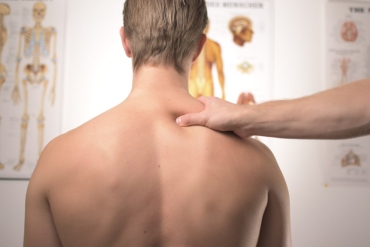Overview: Shoulder injuries are repeatedly seen to impact the careers of tennis players at all levels of play. The shoulder complex comprises 4 different joints, each contributing to the great amount of mobility and stability seen during complex shoulder movements. When this delicate equilibrium between mobility and stability is compromised, the shoulder is vulnerable to injury.
Why is the shoulder so vulnerable to injury?
Large forces go through the shoulder joint during the tennis serve as energy is transferred from the ground up: ground reaction forces → legs/hips/trunk → shoulder/upper arm
*a break in a link in a proximal segment will create larger demand on the next segments, like the shoulder
What provides stability and mobility in your shoulder during movement?
| Shoulder Mobility | Shoulder Stability |
| Shoulder blade control is vital during the serving motion as it (1) provides a stable base for the arm, (2) rotates upwards to get it out of the way from the arm, (3) moves around the rib cage, and (4) provides a stable base for muscles in the shoulder and upper back | Static stability: provided by your bones, ligaments (at end of range of motion), and joint capsuleDynamic stability: provided by your muscles (at the beginning of the cocking phase of the serve) |
When is the shoulder vulnerable to injury?
There are five phases of the tennis serve: (1) wind up (knee flexion, trunk rotation), (2) early cocking, (3) late cocking (position of maximal demand on the shoulder as you reach up and back), (4) acceleration phase and (5) follow-through. During the late cocking phase, it is your rotator cuff muscles’ job to stabilize the shoulder while it is in a position of extreme range of motion. If your stability or mobility is compromised during this phase, you can develop impingement syndrome, which is one of the most common tennis injuries. Some even call it ‘tennis shoulder.’ Impingement syndrome can occur when lifting the arm between 60-120º of abduction (sideways lifting) or when the lifted arm is rotated inwards. The pain is caused by one of your rotator cuff muscles getting pinched and aggravated. Repetitive impingement can lead to structural damage (e.g. rotator cuff tears).
What are your treatment options?
- Conservative management, including physiotherapy will focus on correcting the anatomical, physiological and bio-mechanical systems at fault. Problem areas can include the kinetic chain, shoulder blade function, and the role of static and dynamic shoulder stabilizers.
- Modalities will help speed up the healing of injured tissues. In more acute injuries, ultrasound and high-power laser therapy can be useful. In chronic injuries, shockwave therapy can be more beneficial. Electro-acupuncture can also be used as a complementary therapy in both acute and chronic injuries.
- Plasma-rich platelet injection (PRP) is a biological treatment involving injection of a portion of the patient’s own blood consisting of a higher platelet concentration to promote healing of damaged tendons, ligaments, muscles and joints.
- Local anaesthetic and steroid injections decrease pain and inflammation (e.g. cortisone injection)
- Surgical intervention involving debridement of damaged rotator cuff tissue, subacromial bursitis, bone spurs and osteophytes, with repair of rotator cuff tears are typically used as a last resort.
References
- Ellenbecker, T.S. “The Relationship between Stroke Mechanics and Injuries in Tennis”. High Performance Coaching; The USTA newsletter for tennis coaches. 2006;8(2):2-10.
- Laudner, K. and Sipes, R. “The Incidence of Shoulder Injury among Collegiate Overhead Athetes”. Journal of Intercollegiate Sport. 2009;2:260-268.
- Mei-Dan, O. and Carmont, MR. “The Role of Platelet-Rich Plasma in Rotator Cuff Repair”. Sports Med Arthrosc. 2011;19(3):244-250.
- Kovacs, M. and Ellebecker, T. “An 8-Stage Model for Evaluating the Tennis Serve”. Sports Health. 2011;3(6):504-513.
- Van der Hoeven, H. and Kibler, WB. “Shoulder Injuries in Tennis Players”. British Journal of Sports Medicine. 2006;40:435-440.



